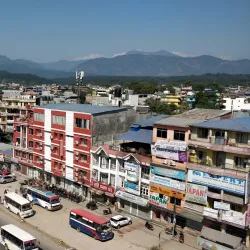Quality of life in Narayangarh
Narayangarh, located in the heart of Nepal, serves as a bustling commercial and cultural hub in the Chitwan District. Known for its strategic position along the Narayani River, Narayangarh connects the eastern and western parts of Nepal, making it a vital trade and transportation center.
The city is characterized by its vibrant markets, diverse population, and a blend of traditional and modern lifestyles. Emerging trends in Narayangarh include a growing emphasis on eco-tourism and sustainable development, reflecting the city's commitment to preserving its natural beauty while fostering economic growth.
History and Culture
Narayangarh's history is deeply intertwined with the development of the Chitwan District. Originally a dense forest area, it was transformed into a settlement area during the mid-20th century as part of Nepal's malaria eradication and resettlement programs.
The cultural landscape of Narayangarh is rich and diverse, influenced by various ethnic groups including the Tharu, Brahmin, and Chhetri communities. This diversity is reflected in the city's festivals, cuisine, and daily life, offering a unique blend of traditions and modernity.
Key cultural institutions in Narayangarh include local theaters and community centers that host a variety of cultural events and performances. The city's proximity to Chitwan National Park, a UNESCO World Heritage Site, adds to its cultural significance, offering insights into the region's biodiversity and conservation efforts.
Things to do in Narayangarh
Visitors to Narayangarh can explore the vibrant local markets, which offer a range of goods from fresh produce to traditional handicrafts. The city's bustling bazaars are a testament to its role as a commercial hub.
For those interested in nature and wildlife, a visit to the nearby Chitwan National Park is a must. The park offers safari tours where visitors can spot rare wildlife such as the Bengal tiger and one-horned rhinoceros.
Cultural enthusiasts can participate in local festivals such as the Tharu cultural celebrations, which showcase traditional music, dance, and cuisine. These events provide a glimpse into the rich cultural tapestry of the region.
See top attractions and things to do in NarayangarhQuality of Life Rankings
The Quality of Life Rankings for Nepal reflect how livable a city in Nepal is. It considers factors like purchasing power, pollution, housing affordability, cost of living, safety, healthcare, commute times, and climate. A higher index score means a better quality of life.
Weather in Narayangarh
Narayangarh, Nepal experiences a humid subtropical climate characterized by hot, humid summers and mild to cool winters. The city receives an average annual precipitation of approximately 80 inches (2032 mm), with July being the wettest month, averaging around 20 inches (508 mm) of rainfall.
Seasonal Breakdown
- Spring (March to May) - Temperatures gradually rise from an average high of 77°F (25°C) in March to 88°F (31°C) in May. Rainfall begins to increase towards the end of the season, with May receiving around 5 inches (127 mm) of precipitation.
- Summer (June to August) - The hottest months, with average highs ranging from 90°F (32°C) in June to 92°F (33°C) in July. This period is also the monsoon season, with heavy rainfall, especially in July, averaging around 20 inches (508 mm) per month.
- Autumn (September to November) - Temperatures gradually decrease from an average high of 88°F (31°C) in September to 77°F (25°C) in November. Rainfall decreases significantly after the monsoon, averaging around 4 inches (102 mm) per month.
- Winter (December to February) - The coldest period, with average highs ranging from 70°F (21°C) in December to 68°F (20°C) in February. Rainfall is minimal, averaging about 1 inch (25 mm) in January.
Notable Weather Events
- Monsoon rains causing occasional flooding in July and August.
- Heatwaves during late spring and early summer.
- Cooler temperatures and foggy mornings during winter months.
Narayangarh's Political Climate
Narayangarh, a bustling city in Nepal, serves as a significant hub for commerce and trade in the region. The political climate in Narayangarh is shaped by its strategic location and its role as a gateway to the Chitwan National Park. The city is governed by a local municipal council, which is part of the broader federal democratic republic system of Nepal. Political affiliations in Narayangarh are diverse, with representation from major national parties such as the Nepali Congress and the Communist Party of Nepal (Unified Marxist–Leninist).
Historically, Narayangarh has been a site of political activism and engagement, reflecting the broader national trends in Nepal. The city has seen significant political events, including local movements advocating for environmental conservation and sustainable tourism, given its proximity to natural reserves. Current political leadership in Narayangarh focuses on balancing development with ecological preservation, a key issue for the residents.
Narayangarh has implemented several progressive policies, particularly in areas of environmental sustainability and social justice. Initiatives to promote eco-friendly tourism and enhance local infrastructure are underway, reflecting the city's commitment to sustainable development. These policies are influenced by the city's political climate, which prioritizes economic growth while maintaining social and environmental responsibility.
Recent political trends in Narayangarh include a growing emphasis on civic engagement and transparency in governance. The city has witnessed increased participation in local elections, indicating a robust democratic process. This trend is supported by local movements and NGOs that encourage voter education and political participation.
Political Quick Facts
- Ram Bahadur Thapa - Former Minister of Home Affairs and influential leader in local politics.
- Pushpa Kamal Dahal - Prominent political figure with significant influence in the region.
- Bishnu Prasad Paudel - Key member of the CPN-UML with a focus on economic policies.
"Key Takeaways"
Narayangarh is a key commercial and cultural hub in Nepal, strategically located along the Narayani River.
The city is experiencing growth in eco-tourism and sustainable development, reflecting its commitment to environmental preservation.
Narayangarh offers a rich cultural experience with diverse festivals, local markets, and proximity to Chitwan National Park.










